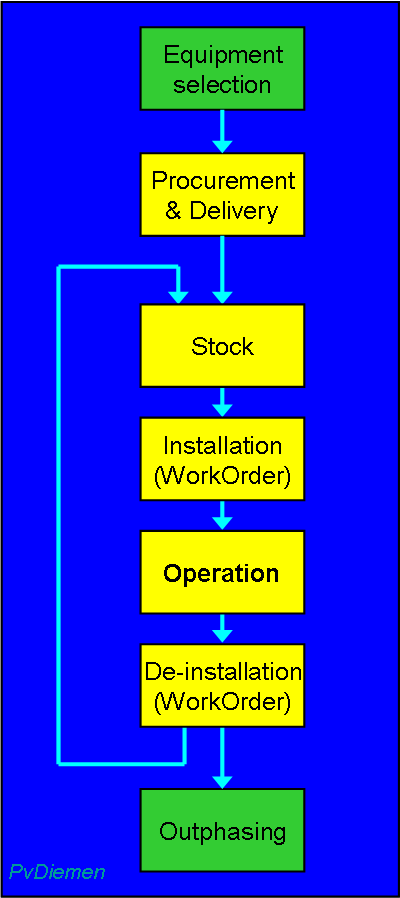Last update
PvD
3.3.1 Equipment life cycle
Overview
 Equipment selection
Equipment selection- This includes the vendor selection process and results in a (framework) contract. Equipment creation (design, develop & manufacture) is part of the vendor's process. The operator is responsible for validation of proper operation in his environment (through an 'Acceptance test').
- Procurement & Delivery
- This is the ordering process to the vendor (instigated by Capacity Management) of equipment and the delivery (hand-over, including delivery verification test) of that equipment to the operator at a central location (stock) or at the destination site.
- Stock
- Storing equipment (spares may be kept separate).
- Equipment provisioning (by Work Order)
- Installation, configuring, test & commissioning (cut-over). It includes installation/configuration verification test, and during the operational time, various tests and potentially repairs. Large-scale replacement of old equipment requires a migration plan.
- Operation
- In this state, the Service Provisioning cycle may use it (multiple times).
- Deprovisioning
- With equipment deprovisioning there are two options (trade-off; see also section 'Capacity Management'):
- equipment remains in place but is locked precluding further use (Administrative state = Locked); or
- equipment is de-installed (by Work Order; this could be a strap).
- Outphasing
- Finally, equipment will be removed from the network altogether and sold/scrapped (probably replaced by more modern equipment). This involves a migration path.
Obviously, Equipment Management must keep track of the location and status of all equipment. For configured equipment its containment in sites is important.
This seems al very obvious and simple, but practice is less straightforward.
Conventionally, equipment management is done in a normal database off-line from Network Management (e.g. ERP). However, for equipment in the network such databases often prove to be considerably out-of-date, which makes them unreliable hence hardly usuable. Integrating (that part of) the database in Network Management operations proves to work much better.
=O=
 Equipment selection
Equipment selection Equipment selection
Equipment selection